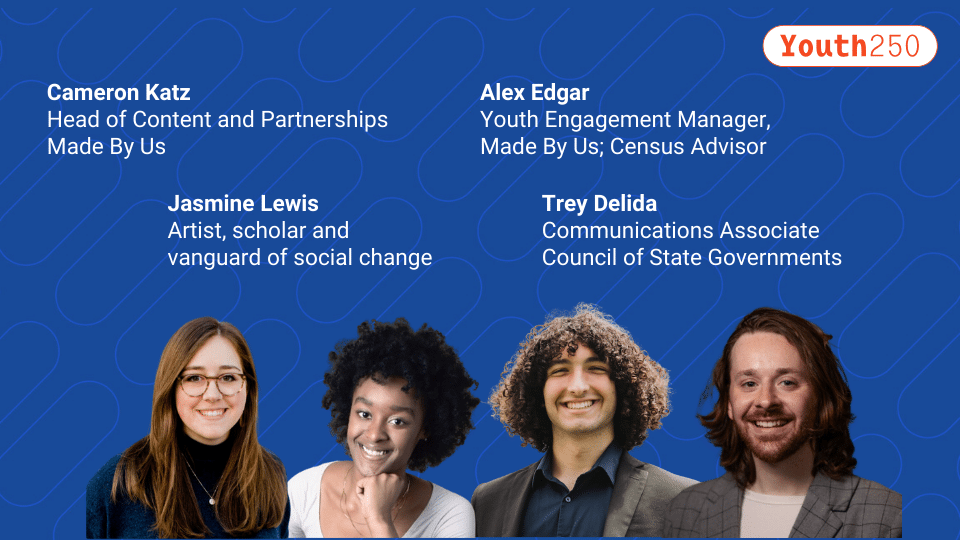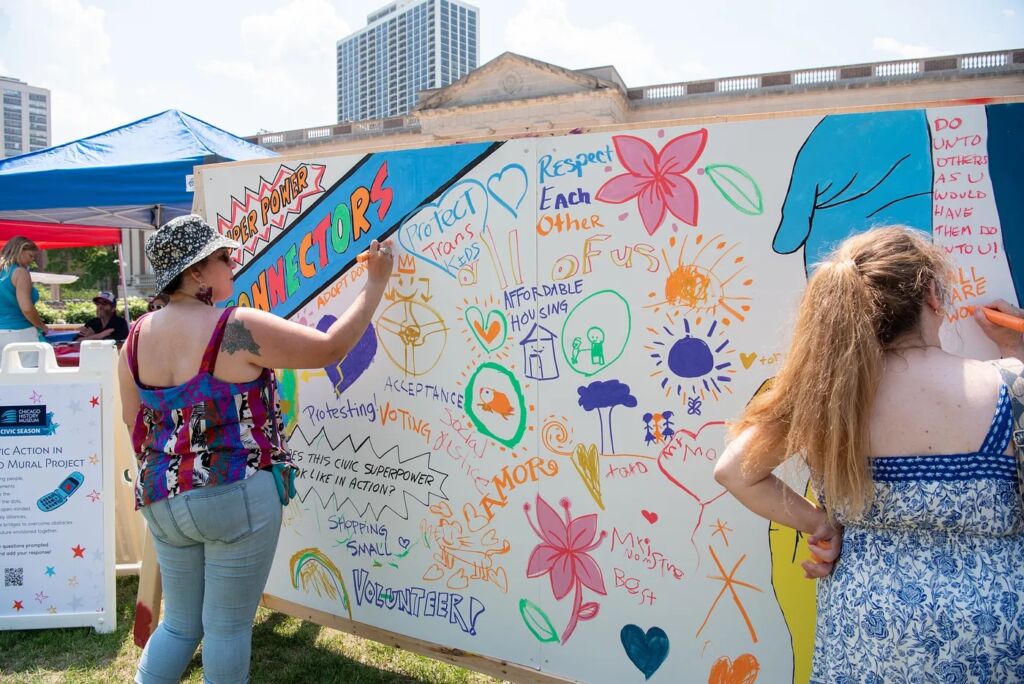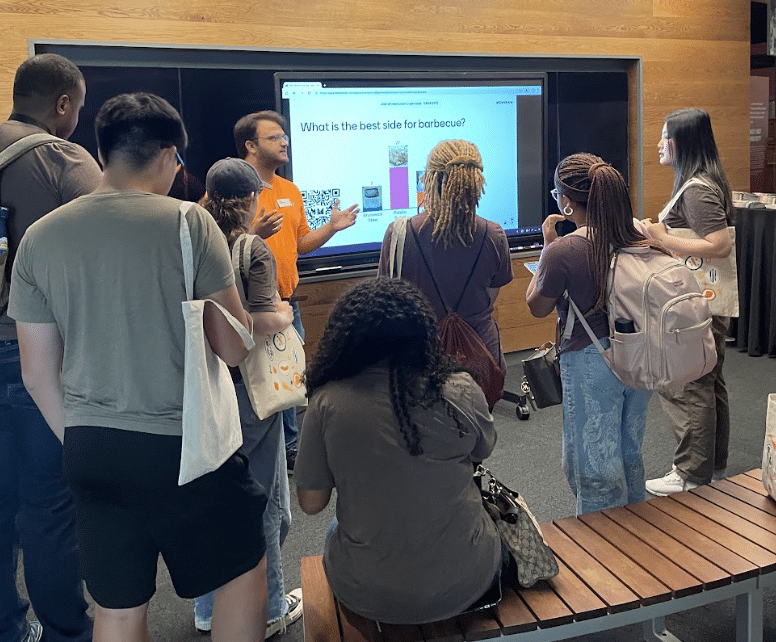
–By John Dichtl, AASLH President and CEO
“The United States turns 250 years old in 2026. Gen Z will write its next chapter.”
For all AASLH has done to encourage thoughtful planning for the nation’s 250th, we still have work to do to get younger people involved. So far, we have primarily relied on highlighting approaches from history organizations that are connecting well to Gen Z or shared strategies from our colleagues at Made By Us. For more than six years, Made By Us, a collaborative enterprise founded by some of the nation’s best known history museums, has been exploring ways to increase youth participation—as visitors, practitioners, learners and contributors—in the 250th and in history organizations generally.

Made By Us has an impressive track record. It has been activating Gen Z participation around reimagined, re-invigorated commemorative moments: for the last four years, hundreds of organizations have taken part in the annual Civic Season, between Juneteenth and July 4th. Now Made By Us is readying its newest endeavor, Youth250, a suite of resources, to ”help institutions serve younger generations and create avenues for youth input across society.” Youth250 resources range from a toolkit, to research, to a national youth advisory bureau.
As part of this initiative, the AASLH 2024 Annual Conference in Mobile, Alabama, will feature a special panel of Gen Z voices articulating their ideas, concerns, and needs for the 250th, alongside interactive exercises for attendees.
I connected with the panelists ahead of the conference to get their thoughts on what might work well for this commemorative moment and what we can learn from younger people about their world. Read on to hear the perspectives of these young adult panelists. If you can make it to Mobile next month, stop by the Made By Us table at the AASLH Conference and come to the Thursday, September 12, morning session, “Engaging Younger Generations in the U.S. 250th Anniversary.”

Meet the panelists:
- Cameron Katz is the Head of Content and Partnerships with Made By Us.
- Trey Delida is a writer, digital marketer, and Communications Associate with the Council of State Governments.
- Jasmine Lewis is a multi-intentional artist, scholar, and vanguard of social change who is envisioning a kaleidoscopic path towards liberation.
- Alex Edgar is the Youth Engagement Manager with Made By Us, developing Youth250.
John Dichtl: What are the biggest hurdles for getting younger generations involved with and excited about the 250th?
Cameron Katz: The 250th is meant to celebrate our country’s history and spirit, but only 16% of Gen Z is proud to live in America. We are going to have to overcome the significant apathy and disillusionment that Gen Z is feeling about our country. One way history institutions can do that is by leaning into the complexity of our history—not just the fireworks and hot dogs that come with 1776. We need to share stories from the past 250 years that show the good and the bad of our history and the continuous effort to reach towards our founding ideals. Additionally, rather than only focusing on the past 250 years, we need to look forward to the next 250. How can we empower Gen Z to build the country we want to live in? How can we infuse the 250th with hope that our best days are ahead of us?
Jasmine Lewis: Many young people are deeply cynical about America’s future because of the complex and brutal patterns of its past. We (Gen Z) have repeatedly witnessed legislation that places barricades against our well-being and against the ways that we express ourselves, especially within recent years. We’ve seen the ways that students’ access to history has been deemed a threat by people in power.
The most important practice for younger generations is to remain aware, imaginative, and hopeful. To reckon with the histories that our nation holds and familiarize ourselves with our current condition, and, at the same time, become invested in forging a path forward. We should see the 250th as an opportunity to focus on the questions: “What kind of future can I imagine that makes me and my loved ones feel the most free, the most nurtured by our communities, and feel the most safe within and outside of ourselves?
Trey Delida: There is a universally bleak outlook of America’s first 250 years, and many Gen Z recognize that we cannot continue the way we have. As macabre as it may sound, many of us have no hope for any lasting change to occur until older generations let go of the wheel. That’s where we have an opportunity to invigorate Gen Z: let us lead.
Above all, our generation wants to feel as though we are making an impact on the world around us. According to a recent study from StandfordReport that assesses Gen Z values in the workplace, our generation expects change and we want to make a difference. The 250th is a perfect opportunity to play on these established characteristics. However, it relies on a certain level of trust from older generations and a willingness to let hierarchy take a backseat.
The only way to invoke hope from Gen Z is to let us have a say in what lies ahead for our country. Otherwise, we’re just waiting our turn.
John: What do you hope your generational peers—who are probably not yet paying much attention to the approach of the Semiquincentennial—will be most surprised or captivated by when 2026 gets here?
Cameron: I would love it if my peers could find more inspiration in the American story. Part of my work with Made By Us is leading our social media channels, where we share lesser known history with young adults. Through this work, I’ve learned about inspiring historical figures like Yuri Kochiyama, José Sarria, and Janet McCloud. I’ve learned about movements like Freedom Summer, Washington, D.C.’s Black Renaissance, and the San Francisco protests that led to the passage of the Americans with Disabilities Act. Although I studied history in college, there was (and still is) so much I don’t know about all of the people, places, and movements that have shaped our nation.
When I am feeling disillusioned with our country, I feel that I now have so much history I can lean on to lift me out of that hopelessness, while still recognizing that our country has never been perfect. Many of my peers did not have the interest or opportunity to study history at the college level, and so I feel that they have not had the chance to learn these valuable stories. I hope the 250th can change that.
Jasmine: I’m excited for people to feel invigorated by the essence of possibility, by excitement for futurity! It’s no secret that many of us are ready, and have been ready, for change. It’s evident in the ways that we show up for the causes and social injustices that we care about and how we share and support each other with information through social channels and media-making. For those who aren’t really thinking about America’s anniversary at the moment, I hope they will feel a sense of catharsis when it arrives. Like a welcoming for elements of newness that will sustain the betterment of this nation.
There’s quite some time between 1776 and 2026, and I hope that the thought of that encourages people to look into the histories that are all too underspoken. There are so many movements that are usually skimmed over. I often think of those that amplify the importance of intercommunal and transnational solidarity, like Fred Hampton’s Rainbow Coalition; and of legacies of poetic artists like Audre Lorde, Octavia Butler, Toni Morrison, Zora Neale Hurston, Nina Simone, and Toni Cade Bambara. I hope that more people will feel captivated to dive into the works of the many that have made new worlds possible, so that they can realize that same power within themselves.
Alex Edgar: Right now young people’s distrust in our government and institutions is at an all-time high, and our access to a constant stream of news on our devices means that there is always something negative to share. My hope is that my fellow Gen Zers are able to recognize the power we all have in shaping the future of the American story, especially as we reckon with the past 250 years of American history. There is no one right way to engage with this moment, but I hope my generation is able to see that leaders are increasingly open to hearing young people’s voices and that often history is made by underrepresented voices tapping into existing systems to provoke change. There is still a lot of work that needs to be done to ensure we are ready to meet the moment, but I’m excited to see how young people from every corner of our country will be able to connect with aspects of our shared history that historically haven’t seen the light of day.
John: What are some examples of public history organizations doing a good job of working with younger members of their communities to make 250th plans?
Cameron: Carpenter’s Hall in Philadelphia has led the way so far with a Youth Continental Congress this past summer, and we’ve seen amazing programming come to life throughout the country during Civic Season—the ultimate “test kitchen” for the 250th, held between Juneteenth and July 4th since 2021. Pizza parties, Amazing Races, self-care events, digital content—it’s been invigorating to see the appetite for creativity and experimentation, since “relevance” is of course a moving target. But we know history organizations need greater access to younger people’s ideas and input, and that’s why we’re developing Youth250, which Alex is leading.
Alex: This need is exactly why we started Youth250. In every conversation, meeting, and convening about the 250th we’ve been to, there is a strong emphasis on reaching young people—but they are not widely represented in the planning process. Later this fall, Made By Us will be recruiting 100+ diverse 18-to-30-year-olds from across the country for a stipended program that connects our advisors with institutions planning for the 250th to ensure our voices are not lost in this pivotal moment. As a proud Gen Z organizer, I am thrilled to help bridge the gap between my generation and institutions, particularly at this historic anniversary.
John: Is there anything you keep hearing from public history organizations and other Semiquincentennial-focused organizations that you find counterproductive for making the 250th a truly inclusive and meaningful experience for all people?
Cameron: We have a loneliness epidemic, and our fragmented American identity isn’t helping. I see the 250th as an opportunity to not only share important stories from our past, but to also begin repairing our disconnected communities. Museums can be the conveners, but we’re not going to reconnect with our neighbors through a lecture series. Don’t get me wrong—I love a lecture!—but we can do more to foster community. Give me pizza parties, trivia nights, scavenger hunts, and wine tastings! Give me a chance to talk to people I might not have otherwise. Fun events can help get Gen Z in the door, but they truly benefit everyone.
Jasmine: Third spaces—places for informal social interaction—are becoming increasingly scarce, and so are educational experiences that honor the vast and varied histories of this nation and the people who inhabit and inherit it. The cool part about museums is that they can often function as a source of both—providing opportunities for gathering, and for collective learning experiences! I’m interested in seeing how creative history and cultural centers can be when it comes to furnishing spaces for communal celebration and other get-togethers. Maybe even a few collaborations between museums, libraries and other local organizations. I hope the 250th urges these places to lean more into wonder and interdisciplinarity for how we share time together.
John: What’s the single most useful piece of advice about technology and younger audiences that you can give to museums and other public history organizations?
Trey: Being raised in the era of technology, young folks have a sixth sense when it comes to authenticity. Contrary to popular belief, we care deeply about authentic interactions online and in real life. When formulating content or creating your social calendar, rely on us. Trust your Gen-Z coworker with more than just memes—we have literally grown up with the internet and are really the first generation that uses it frequently to forge relationships and maintain connections with various communities. In the world of tech, museums have to find a way to create spaces online that foster communities.
Jasmine: Oftentimes, technology can be used as a point of accessibility—especially for those of us who have grown within a tech-fueled world. As I’ve been reframing my perspective of what defines “technology” and co-creating an ethos and framework for Black Southern Tech Studies, I’ve come to realize that our “technologies” (including, and outside of, our traditional forms of “tech,” i.e. digital tools, machines, software, etc.) are our channels towards understanding and working with/through the world that surrounds us. With that in mind, I feel that all history organizations should look to technology as a resource to expand reach and to create multimedia experiences for those who are interested in the organization’s resources.
John: What change in the museum and public history field would you most like to see emerge from the Semiquincentennial?
Jasmine: Let’s have more conversations with the people—the torch-bearers—who are doing the work to preserve and amplify history alongside museums! There are so many archivists, storytellers, ethnographers, and cultural workers that are doing incredible work to illuminate myriad histories while capturing current moments. I think about people like Dr. Zandria Robinson (sociologist, writer, ethnographer from Memphis, Tennessee), Ismatu Gwendolyn (healthcare specialist, essayist, thinker-in-praxis from Sierra Leone), and Amarie Gipson (writer, librarian, art-worker from Houston, Texas)—each of whom I’ve been grateful to speak with about the significance of their work. Each of them is a trailblazer in their own right who merges understanding and reckoning with the past, forming tools for the present, and portraying visions for the future.
I would also love to see more resources and workshops for aspiring archivists and historians who want to follow in the footsteps of the work that museums and cultural centers are doing.
Cameron: Museums already do so much in their communities to create space for the gray area, but I would love to see history institutions be the leaders in cultivating nuance and credible information online. In a world of seven-second clips and hot takes, museums have an opportunity to step up and push us to think more critically, to see things from multiple perspectives, and avoid jumping to conclusions. Although some museums may think that Gen Z has no interest in dense and nuanced information, I’ve found that there is a huge appetite for this type of storytelling online.
For example, Made By Us has had a lot of success placing long-form history articles in Teen Vogue that often tackle scholarly topics using archival research, like this article about a queer servant in 17th century Jamestown or this one that dives into the history behind Killers of the Flower Moon—and the research that led to it. Gen Z wants this information, but it just needs to be packaged in an accessible way. And museums are the best institutions to bring these credible, nonpartisan stories to online discourse.
Some responses have been edited for clarity.
